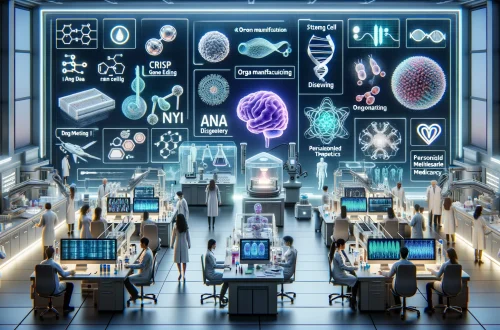
Investing in 2024: Part 2 Robotics
With robotics, we are referring to a broad spectrum of innovations that encompass walking humanoid robots, autonomous vehicles such as robot taxis, flying cars, and unmanned aerial vehicles (UAVs). The robotics industry is experiencing a rapid expansion, projected to increase in value by 80% annually. This growth is fueled by the convergence of several advanced technologies, including artificial intelligence (AI), edge computing, drone technology, and sophisticated sensors, which are enabling capabilities that were unimaginable just a few years ago.
LIDAR: Revolutionizing Perception
Light Detection and Ranging (LIDAR) technology has seen dramatic advancements over the past decade. Modern LIDAR systems are now 1000 times smaller and 100 times cheaper than their predecessors, making them more accessible and practical for a variety of applications. LIDAR uses laser beams to measure distances to objects, creating detailed 3D maps of environments. This technology is crucial for autonomous vehicles and robots, allowing them to navigate and understand their surroundings with high precision. The miniaturization and cost reduction have also enabled integration into smaller devices, opening new possibilities for robotics in fields like agriculture, logistics, and personal assistance.
Image Recognition: Enhanced Accuracy and Speed
Image recognition technology has become significantly faster and more reliable, thanks to advancements in AI and machine learning. Modern image recognition systems can process and analyze visual data in real-time, enabling robots to identify objects, people, and even complex scenes with high accuracy. This capability is essential for applications such as autonomous driving, where the vehicle must recognize and respond to traffic signs, pedestrians, and other vehicles instantly. In industrial settings, robots equipped with advanced image recognition can inspect products for defects, ensuring quality control with unprecedented efficiency.
Reinforcement Learning: Smarter Humanoid Robots
Reinforcement learning (RL) is a type of machine learning where an agent learns to make decisions by performing actions and receiving feedback from the environment. This technique is particularly effective in training humanoid robots, which need to perform complex tasks that require adaptability and learning from experience. By using RL, humanoid robots can improve their performance over time, learning to walk, navigate obstacles, and manipulate objects with increasing dexterity. The iterative learning process allows these robots to optimize their actions based on rewards and penalties, leading to more robust and capable robotic systems.
Networked Robotics: Collective Intelligence
The advent of wireless networking technology enables robots to connect and communicate with each other, forming a collective intelligence. When robots are linked via wireless networks, they can share data, experiences, and learning outcomes. This interconnectedness means that when one robot learns something new, such as navigating a complex environment or performing a specific task more efficiently, that knowledge can be instantly shared with all other connected robots. This collective learning accelerates the development and deployment of robotics solutions, as improvements are propagated throughout the network without the need for individual training.
The Future of the Robotics Market
The projected market value of the robotics industry ranges from $150 billion to $1 trillion USD over the next 15 years. This significant growth reflects the increasing adoption of robotics across various sectors, including healthcare, manufacturing, logistics, and consumer services. Innovations in AI, edge computing, sensor technology, and connectivity are driving this expansion, making robots more capable, affordable, and integrated into everyday life. As these technologies continue to evolve, we can expect to see even more groundbreaking applications and widespread adoption of robotics in our daily activities and industries.
How to invest in robotics?
Investing in the robotics industry offers significant opportunities for growth as this field continues to expand rapidly. Here are some key companies and their contributions to the robotics sector:
Teradyne (TER)
Teradyne Robotics, in collaboration with NVIDIA, is at the forefront of integrating AI into robotics. This partnership focuses on leveraging NVIDIA’s powerful AI technology to enhance the capabilities of Teradyne’s robots, making them smarter and more efficient. Teradyne is well-known for its automation solutions used in testing and industrial applications, and its foray into AI-driven robotics is poised to drive substantial advancements in the field.
FigureAI
FigureAI is an AI robotics company dedicated to developing general-purpose humanoid robots. These robots are designed to perform a wide range of tasks, making them versatile solutions for various industries. FigureAI’s focus on creating adaptable and intelligent humanoid robots positions it as a significant player in the robotics market, particularly in sectors requiring flexible automation solutions.
Tesla (TSLA)
Tesla is expanding its innovative prowess beyond electric vehicles into the realm of robotics with its Optimus humanoid robot. This general-purpose robot is designed to handle tasks that are dangerous, repetitive, or mundane for humans. Additionally, Tesla is set to announce its RoboTaxi service this summer, which will utilize autonomous driving technology to offer a new mode of transportation. These ventures signify Tesla’s commitment to revolutionizing both robotics and autonomous driving.
Mobileye (MBLY)
Mobileye, a leader in autonomous driving technology, focuses on developing advanced driver-assistance systems and self-driving solutions. Mobileye’s technology is integral to the development of autonomous vehicles, enhancing safety and efficiency on the roads. Investing in Mobileye provides exposure to the burgeoning market of autonomous transportation, which is expected to grow significantly in the coming years.
Aurora Innovation
Aurora Innovation is dedicated to advancing self-driving vehicle technology. The company develops sophisticated software and hardware systems that enable vehicles to navigate autonomously. Aurora’s partnerships with major automotive manufacturers and its innovative approach to autonomous driving make it a key player in the future of transportation.
Boston Dynamics
Boston Dynamics is renowned for its cutting-edge robotics, particularly the Atlas robot. Atlas is a highly advanced humanoid robot capable of performing complex maneuvers and tasks, demonstrating the potential of robotics in both industrial and domestic settings. Boston Dynamics’ continuous innovation in robot mobility and functionality makes it a leader in the robotics industry.
Agility Robotics
Agility Robotics is the creator of Digit, a bipedal robot designed for logistics and delivery applications. Digit is used by companies like Amazon to streamline warehouse operations and enhance delivery efficiency. Agility Robotics’ focus on developing practical and functional robots for real-world applications underscores its importance in the logistics and e-commerce sectors.
1X Technologies
1X Technologies, a Norwegian company, produces NEO, a lightweight robot designed to assist with tasks at home. NEO aims to improve everyday life by handling household chores and providing support to individuals with mobility challenges. 1X Technologies’ emphasis on creating user-friendly home robots positions it as a key player in the consumer robotics market.
Sanctuary AI
Sanctuary AI is known for its Phoenix AI Robot, a general-purpose humanoid robot designed to operate in various environments. Sanctuary AI focuses on creating robots that can learn and adapt to new tasks, making them highly versatile solutions for both commercial and industrial applications. This adaptability makes Sanctuary AI a significant contributor to the future of robotics.
Apptronik
Apptronik is developing Apollo, a general-purpose humanoid robot intended for use in warehouses and manufacturing plants. Apollo is designed to assist with repetitive and physically demanding tasks, improving efficiency and safety in industrial settings. Apptronik’s focus on creating robust and reliable robots for heavy-duty applications highlights its potential in the industrial robotics market.
Conclusion
Investing in the robotics industry involves recognizing the potential of various companies that are pioneering advancements in robotics and automation. Each of these companies contributes uniquely to the field, whether through developing cutting-edge AI-driven robots, enhancing autonomous driving technology, or creating practical solutions for industrial and domestic use. By understanding the specific areas of focus and innovation of these companies, investors can make informed decisions to capitalize on the growth and transformative impact of the robotics industry.
Disclaimer
While Robotics presents exciting investment opportunities, this is not investment advice. Investments are always at your own risk. It’s crucial to do your own research and consider your financial situation before investing.



